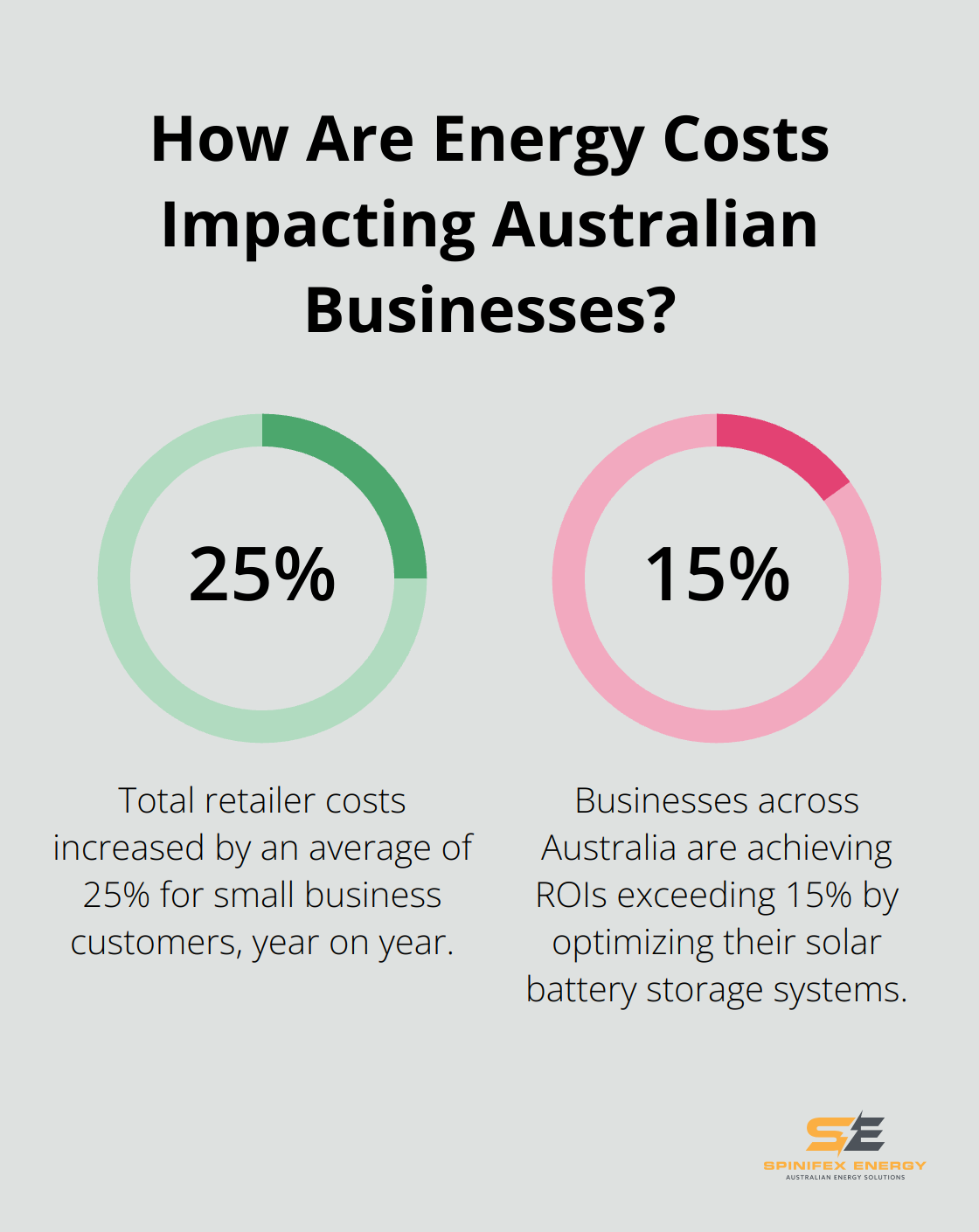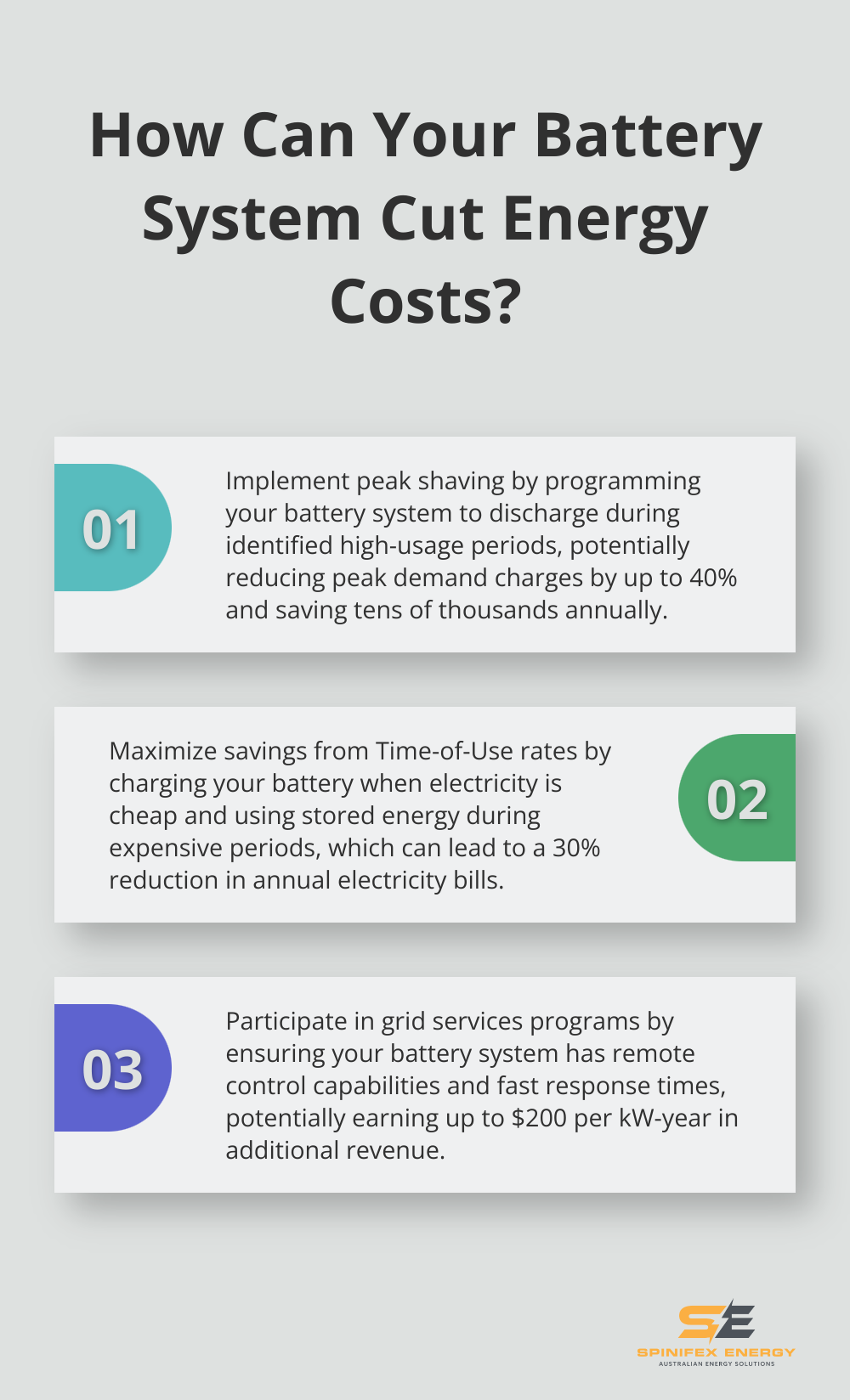At Spinifex Energy, we’ve seen a surge in businesses seeking the best solar battery storage solutions for their commercial needs.
The right battery system can significantly reduce energy costs, provide backup power, and even generate additional revenue streams.
In this post, we’ll explore top commercial solar battery options and key factors to consider when choosing the ideal system for your business.
Top Commercial Solar Battery Storage Solutions
At Spinifex Energy, we’ve tested and implemented various commercial solar battery storage solutions. Our experience shows that certain models consistently outperform others in reliability, efficiency, and overall value. Here’s our breakdown of the top performers in the market:
Tesla Powerpack: The Powerhouse
Tesla’s Powerpack excels as a robust solution for large-scale commercial applications. Each unit can store over 3.9 MWh of energy-that’s enough energy to power an average of 3,600 homes for one hour. The Powerpack’s scalable design allows for expansion to multiple MWh capacity.
LG Chem RESU: Versatility Meets Performance
LG Chem’s RESU series suits small to medium-sized businesses. The RESU10H provides 9.8 kWh of usable capacity with a 95% depth of discharge. Its compact design and easy installation make it popular among installers. Properly sized RESU systems help businesses achieve energy independence rates of up to 80%.
Sonnen eco: Intelligence and Longevity
The Sonnen eco stands out for its smart energy management capabilities. It offers exceptional longevity with a 10,000-cycle life. The eco’s self-learning algorithm optimizes energy use based on consumption patterns, weather forecasts, and electricity prices. Businesses using Sonnen eco systems reduce their reliance on grid power by an average of 75%.
BYD Battery-Box Premium: Flexibility and Scalability
BYD’s Battery-Box Premium series (available in high-voltage [HVS] and medium-voltage [HVM] options) offers unparalleled flexibility. Its modular design allows for easy capacity expansion, starting from 5.1 kWh up to 66 kWh for HVS and 11.0 kWh to 66 kWh for HVM. BYD systems in various commercial settings achieve payback periods as short as 5 years in high-energy-cost areas.

While these systems lead the market, the best solution depends on your specific business needs, energy consumption patterns, and budget. A thorough energy audit and simulation will determine the most cost-effective and efficient solution for your business.
The next crucial step in selecting the right commercial solar battery storage system involves understanding the key factors that influence performance and return on investment. Let’s explore these factors to help you make an informed decision for your business.
How to Choose the Right Solar Battery Storage
Selecting the optimal solar battery storage system for your business requires careful consideration of several key factors. This chapter explores the essential elements that influence the performance and return on investment of commercial battery systems.
Energy Capacity and Power Output
Energy capacity, measured in kilowatt-hours (kWh), determines the amount of electricity a battery can store. Power output, measured in kilowatts (kW), indicates the rate at which the battery discharges stored energy. Most businesses require a minimum capacity of 30 kWh and a power output of at least 10 kW. However, these figures can vary significantly based on specific energy needs and consumption patterns.

To determine the ideal capacity and output for your business, conduct a thorough energy audit. Analyze your peak demand periods and daily consumption patterns. A manufacturing facility operating 24/7 might need a larger capacity battery with high power output to manage constant energy demands. An office building with typical 9-5 hours might benefit from a smaller system focused on peak shaving during business hours.
Longevity and Warranty
The cycle life of a battery (the number of charge and discharge cycles it can undergo before significant degradation) is vital for long-term value. Standard performance warranties typically guarantee 90% capacity up to 10 years, and 80% capacity up to 25 years.
Warranty terms are equally important. A comprehensive warranty should cover not just the hardware but also the battery’s performance over time. This type of assurance can significantly impact your system’s long-term economics.
Scalability and Future-Proofing
As your business grows, your energy needs may change. Choose a modular system that allows for easy expansion. Some battery systems enable businesses to start with a smaller capacity and scale up as needed without replacing the entire system.
Consider your future energy goals when selecting a battery system. If you plan to expand your solar array or add electric vehicle charging stations in the coming years, choose a battery system that can accommodate these additions seamlessly.
Integration Capabilities
The ability of your battery storage system to integrate with your existing or planned solar installation is paramount. Look for systems with advanced inverter technologies that can efficiently manage the flow of energy between your solar panels, battery, and the grid.
Some battery systems come with their own inverters and energy management software. Others may require separate inverters or controllers. Ensure that the system you choose is compatible with your current setup and can be easily integrated into your broader energy management strategy.
Businesses that carefully consider these factors when selecting their solar battery storage systems achieve significantly better results. Well-matched systems have led to reductions in energy costs of up to 80% and payback periods as short as 4-6 years in high-energy-cost areas (based on industry averages).
The next chapter will explore how to maximize your return on investment with solar battery storage, including strategies for peak shaving, demand charge reduction, and participation in grid services programs.
How Solar Battery Storage Boosts Your Bottom Line
Slash Peak Demand Charges
Total retailer costs increased by an average of $904 (25%) for small business customers, year on year. Using stored energy during high-demand periods significantly reduces these charges. A manufacturing plant in Sydney cut its peak demand by 40% with a 100 kWh battery system, saving over $50,000 annually.

To implement this strategy, analyze your energy consumption patterns to identify peak usage times. Program your battery system to discharge during these periods, reducing your draw from the grid. This approach cuts costs and helps stabilize the grid during high-demand periods.
Profit from Time-of-Use Rates
Time-of-Use (TOU) rates offer a prime opportunity for savings. Charging your battery when electricity is cheap and using stored energy when rates are high significantly reduces energy costs. A retail business in Melbourne implemented this strategy and saw a 30% reduction in their annual electricity bill.
To maximize savings, program your battery management system to align with your local TOU rate structure. Some utilities offer special TOU rates for businesses with solar and storage, so check with your provider for the best available options.
Ensure Business Continuity
Power outages cost Australian businesses an estimated $7 billion annually. A robust battery storage system keeps your operations running during grid failures. A data center in Brisbane installed a battery system, ensuring uninterrupted service during outages.
When sizing your battery for backup power, consider your critical loads and desired backup duration. Include automatic transfer switches in your system design to ensure seamless transition during outages.
Tap into Grid Services Revenue
Participating in grid services programs turns your battery into a revenue-generating asset. In some regions, businesses earn up to $200 per kW-year by allowing their batteries to support grid stability. A warehouse in Adelaide earned an additional $15,000 annually by participating in a demand response program with their 200 kWh battery system.
To explore these opportunities, contact your local network operator or energy retailer about available programs. Ensure your battery system meets the technical requirements for participation (which typically include remote control capabilities and fast response times).
Implementing these strategies requires careful planning and expert guidance. Many businesses across Australia optimize their solar battery storage systems, achieving average payback periods of 5-7 years and ROIs exceeding 15%. Tailoring these approaches to your specific energy profile and business needs transforms your energy costs from a burden into a competitive advantage.
Final Thoughts
The best solar battery storage solutions transform businesses’ energy profiles. Tesla Powerpack, LG Chem RESU, Sonnen eco, and BYD Battery-Box Premium offer unique advantages for different commercial needs. These systems combine reliability, efficiency, and scalability to meet diverse operational requirements.

Selecting the right system requires a thorough understanding of energy consumption patterns, future growth plans, and specific business needs. Factors such as energy capacity, power output, cycle life, warranty, scalability, and integration capabilities should guide the decision-making process. Proper implementation of solar battery storage extends beyond cost savings to enhance operational resilience and sustainability.
Spinifex Energy specializes in tailoring energy solutions to meet unique business needs. Our expertise in energy procurement and commercial solar power systems (including innovative battery storage) has helped clients achieve significant savings on electricity costs. We take pride in our data-driven approach, ensuring that investments in solar battery storage set businesses up for long-term success and operational efficiency.

